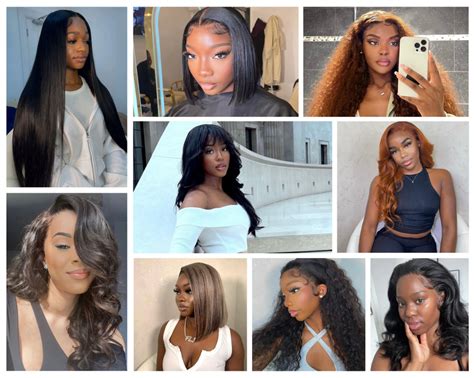Introduction
Wigs have become an indispensable part of fashion, empowering individuals to transform their appearance effortlessly. From adding volume and length to covering hair loss or experimenting with different styles, wigs offer a versatile solution for both men and women.

This comprehensive guide explores 12 must-have wigs for every occasion, addressing your pain points and providing step-by-step instructions for achieving the perfect fit. Embrace the world of wigs and discover how they can enhance your confidence and style.
Understanding the Wig Market
According to the American Hair Loss Association, approximately 100 million Americans suffer from hair loss. The global wig market is estimated to reach $23.6 billion by 2027, reflecting the growing demand for hair replacement solutions.
Wigs are commonly used for:
- Covering hair loss due to medical conditions or treatments
- Enhancing volume and length
- Experimenting with different styles
- Creating theatrical or costume looks
- Protecting hair from environmental damage
Types of Wigs
1. Human Hair Wigs
- Pros: Natural texture and feel, can be styled with heat tools, long-lasting
- Cons: Expensive, require regular maintenance and professional styling
2. Synthetic Hair Wigs
- Pros: Affordable, wide range of colors and styles, low maintenance
- Cons: Can be less realistic-looking, heat-sensitive, shorter lifespan
3. Lace Front Wigs
- Pros: Creates a natural-looking hairline, allows for versatile styling
- Cons: Requires specialized application techniques, time-consuming maintenance
4. Monofilament Wigs
- Pros: Breathable and comfortable, undetectable base, allows for natural hair movement
- Cons: Expensive, requires delicate handling, limited styling options
5. Full Cap Wigs
- Pros: Conceals all of your natural hair, secure fit
- Cons: Can be hot and uncomfortable, requires regular adjustments
6. Toppers
- Pros: Adds volume and covers thinning areas, easy to wear
- Cons: Limited coverage, can be visible if not applied correctly
7. Bangs
- Pros: Instantly transforms your look, frames your face
- Cons: Requires regular trimming and styling, can be difficult to attach
8. Clip-In Extensions
- Pros: Temporary solution, allows for quick and easy transformation
- Cons: Clips can be visible, requires blending with natural hair
9. Tape-In Extensions
- Pros: Long-lasting, secure hold, customizable volume
- Cons: Requires professional application and removal, can damage natural hair
10. Halo Wigs
- Pros: Super-comfortable, halos hide under your natural hair
- Cons: Limited styling options, not suitable for all head shapes
11. Ponytails
- Pros: Versatile, instantly adds length and volume
- Cons: Can be bulky, requires secure attachment to prevent slippage
12. Braids
- Pros: Protective style, adds length and volume
- Cons: Requires regular maintenance, can be time-consuming to braid
How to Choose the Right Wig for You
1. Determine Your Face Shape
- Oval: Most wig styles will suit you
- Round: Opt for wigs with height and volume at the crown
- Square: Choose wigs with soft angles and side-swept bangs
- Heart: Wigs with a round or oval shape will balance your features
- Diamond: Avoid wigs with too much volume or coverage around the forehead
2. Consider Your Hair Loss Pattern
- Diffuse thinning: A full cap wig or topper will provide the best coverage
- Patchy hair loss: A lace front wig or monofilament wig can create a natural-looking hairline
- Traction alopecia: Clip-in extensions or tape-in extensions can avoid putting additional stress on your hair
3. Match Your Wig Color and Texture
- Choose a wig that matches your natural hair color and texture as closely as possible
- Experiment with different highlights or lowlights to add depth
- Consider the occasion when choosing a hair texture: synthetic hair is best for casual events, while human hair is ideal for formal occasions
How to Apply and Style a Wig
1. Prepare Your Natural Hair
- Wash and condition your hair
- If possible, braid or wrap your hair in a bun at the base of your neck
- Apply a wig cap to secure your natural hair and prevent slippage
2. Place the Wig
- Hold the wig gently by the ear tabs
- Align the front of the wig with your natural hairline
- Pull the back of the wig down over your head, adjusting it to fit snugly
- Secure the wig with clips or an elastic band
3. Style the Wig
- Use a brush or comb to gently detangle the wig
- Trim any excess hair that may bother you
- Style the wig using heat tools or styling products as desired
How to Care for Your Wig
- Wash synthetic wigs approximately once per month using a gentle shampoo and conditioner
- Wash human hair wigs more frequently, using a wig-specific shampoo and conditioner
- Air-dry wigs or use a blow dryer on a low heat setting
- Store wigs on a wig stand or in a wig box to maintain their shape
Conclusion
Wigs offer a versatile and empowering solution to enhance your appearance and confidence. Whether you need to cover hair loss, transform your style, or simply experiment with different looks, the world of wigs has something for everyone. Embrace the possibilities, choose the right wig for your needs, and enjoy the transformative power of wigs.
